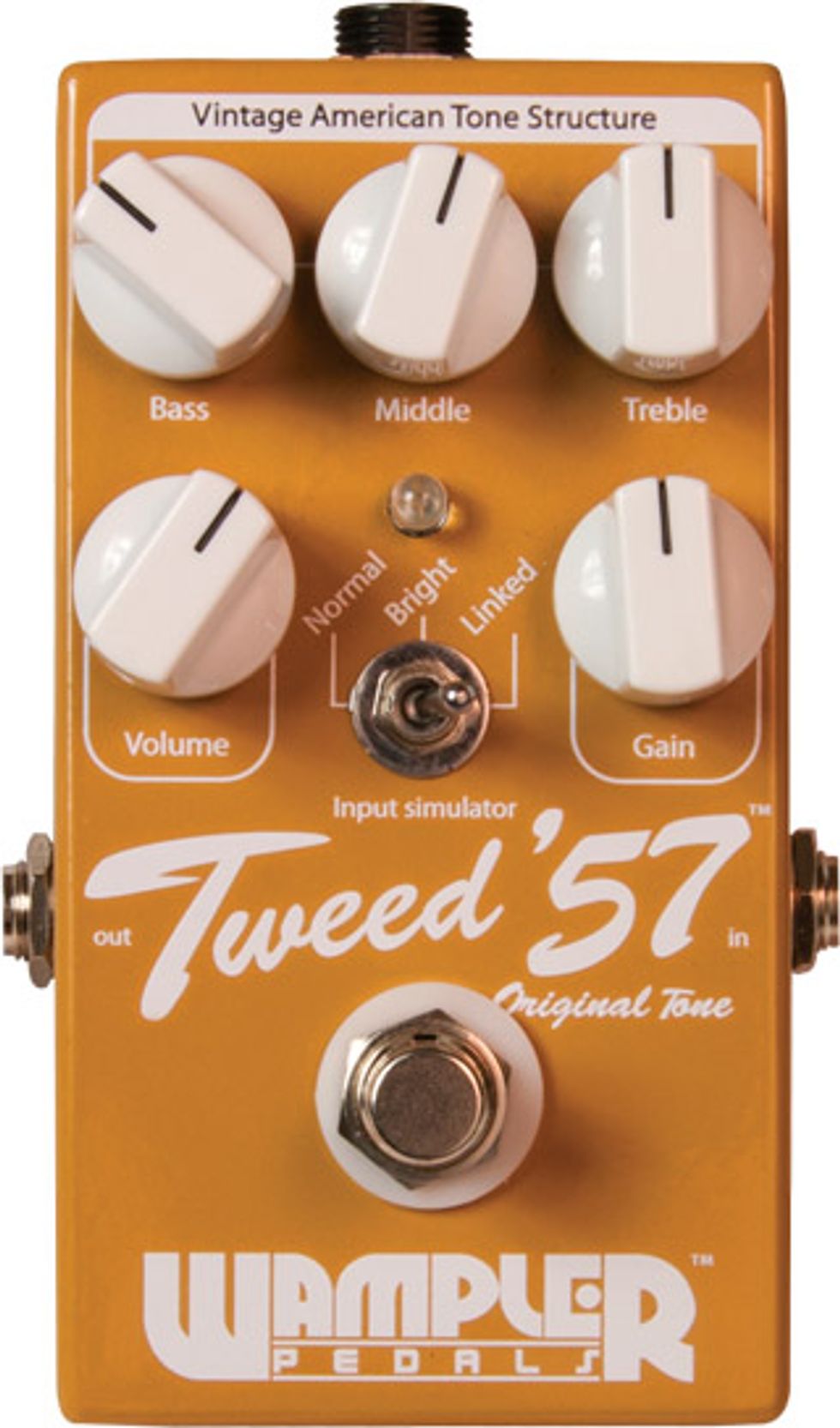
Wampler Pedals specializes in putting amp tones in a box. The company’s Amp in A Box series—which includes the Triple Wreck, SLOstorion, Plextortion, and Pinnacle pedals— does a valiant job of reproducing legendary high-gainamp sounds, while the Heritage series—the Plexi-Drive, Black ’65, and the new Tweed ’57— is all about the classics. While the Tweed ’57 moniker obviously pays tribute to pre-blackface Fender amps, it isn’t designed to replicate a particular model (for example the Champ, Bassman, Deluxe, or Twin). Rather, it replicates the shared dynamics of Fenders from that era and allows you to tailor your tweed sound via its thoughtfully conceived EQ range and a gain control—which tweed amps did not have.
Need for Tweed
The Tweed ’57’s design sprang,
in part, from a collaboration
between Brian Wampler and
the company’s Facebook fans,
who voiced a collective desire
for a box that could deliver the
magically squishy compression
and explosive dynamics of tweed
Fenders. The small enclosure is
tightly packed with controls to
get those tones dialed in: The
top row features bass, mid, and
treble knobs, while volume and
drive knobs, as well as a 3-way
amp-input-simulator toggle
reside just below that. The toggle
lets you choose between simulations
of normal, bright, or linked
inputs, with the latter being a
simulation of bridged normal
and bright inputs—a feature destined
to put a smile on the faces
of die-hard tweed fanatics.
Tweed Put to the Test
I tested the Tweed ’57 using
various humbucker- and singlecoil-
equipped guitars, which
I plugged into a silverface
Fender Princeton Reverb and
a solid-state ZT Amplifiers
Lunchbox. While some pedals
and amps work better with
certain pickup types, the Tweed
’57 seems equally at home no
matter what is thrown its way.
I started with the normal input
selected, gain all the way off,
and volume set for unity gain.
Even at these very moderate settings,
the ’57 added even more
life to the already-great-sounding
Princeton. Through the
Lunchbox, the Tweed ’57 introduced
a tube-like responsiveness
and thickness. I got a very
subtle grit that added authority
to single-note runs, and when
I played barre chords I got a
cool, gritty clean or a Tweedlike
bark, depending on how
hard I strummed. Moving the
input selector to bright opened
up the sound a bit—adding air
and a janglier top end. Set to
linked, the pedal was noticeably
louder—and quite brash.
Ratings
Pros:
Excellent tones, dynamics, and flexibility
across the whole gain spectrum.
Cons:
None.
Tones:
Ease of Use:
Build:
Value:
Street:
$199
Wampler Pedals
wamplerpedals.com
With the gain up high, you can tap into glorious, opensounding sustain reminiscent Larry Carlton’s legendarily smooth solo on Steely Dan’s “Kid Charlemagne.” Even with the gain cranked, there’s a distinct clarity to the notes—and the pedal’s touch sensitivity is nothing short of remarkable. Pick with medium to heavy attack, and notes really sing. Pick lightly, and single notes and chords all sound significantly cleaner. Backing down on the pedal’s volume knob can also change the tonal character significantly. All of this adds up to a wide dynamic range that’s addicting in and of itself—even before you start tweaking and fine-tuning the tones. Not coincidentally, that’s one of the calling cards of a great amp, too.
The Verdict
The Tweed ’57 is a
phenomenal pedal
that sounds and feels more like
you’re playing a cranked amp
than a stompbox. To get even
a low-wattage tweed Champ
to sing, you’d realistically have
to crank it past most acceptable
bedroom volumes. But
the Tweed ’57 gets you there
at just about any volume you
need. But even if you’re not
seeking the raunchy sounds of
a tattered tweed, you can set
the gain low (or off ), and keep
the pedal on to warm up your
amp and give it a touch of that
tweed bite. This is the kind of
pedal that can save your hide
when you have to gig in rooms
of varying size, or when you’re
dealing with a questionable
backline. But no matter how
you use it, there’s no question
the Tweed ’57 is a champ.













![Rig Rundown: John 5 [2026]](https://www.premierguitar.com/media-library/youtube.jpg?id=62681883&width=1245&height=700&quality=70&coordinates=0%2C45%2C0%2C45)






